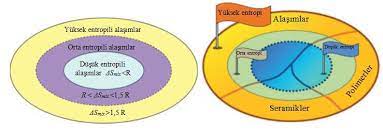
One of the promising areas of electroexplosive nanomaterial powder application is the synthesis of intermetallic and high-temperature compounds. Studies show that particles of electroexplosive nanometarial powder have high defectiveness. It appears to be the reason of the fact that certain nanometarial powder, when heated, discharge energy (Еэ) unrelated to chemical processes. Such an effect was observed when electroexplosive nanometarial powder of metals [1, 2] were heated, for example silver [3, 4].
Fig. 1. Derivation diagram of silver electroexplosive nanomaterial powder when heated in argon atmosphere
Fig. 1 shows that temperature increase up to 215…220 ºС in argon atmosphere launches an exothermic process in silver electroexplosive powder. Energy Еэ is 37% of metal fusion heat (Еэ = 38.73 kJ/kg, silver fusion heat value is 104.7 kJ/kg). The experiment was carried out in Los Alamos National Laboratory, USA.
Table 1. Production of intermetallic compounds
High activity and the peculiarities of the energy state of nanometarial powder allow the production of metal compounds with various melting temperatures, e. g. alfer [5]. Table 1 shows the examples of some reactions, where electroexplosive nanometarial powder were used to form intermetallic compounds [6]. In reactions, metal 1 was represented by nanometarial powder, metal 2 – by a commercial powder or electroexplosive nanomaterial powder. All reactions ran in the self-propagating high-temperature synthesis mode.
Due to the high chemical activity, electroexplosive nanometarial powder can also be used as raw materials for the synthesis of high-heat chemical compounds, such as tungsten carbide [7].
Fig. 2. Typical view of tungsten powder: (a) – scanning electron microscopy, (b) – transmission electron microscopy
For the purpose of carbonization, tungsten powder (Fig. 2) and chips of spectral pure graphite were mixed. The mixture was put into a stainless-steel sealed vessel (Fig. 3).
Fig. 3. Basic diagram of a device for tungsten powder carbonization: 1 – tungsten powder, 2 – chips of spectral pure graphite, 3 – vessel, 4 – heater, 5 – heat insulation, 6 – nipple, 7 – gear motor
Reaction components were weighed in a stoichiometric proportion: for 1% of weight of graphite chips – 15.3% of weight of tungsten powder. The mixture was heated to 1,000 оС for 14 hours. For evener contact of the reaction components and for the prevention of powder agglomeration, the vessel was rotated at the speed of 0.5 revolutions per minute. Excessive pressure in the vessel was reduced by means of a nipple. X-ray phase analysis reveals that the reaction product is tungsten carbide WC (94% of tungsten, 6% of carbon).
Typical views of tungsten carbide particles are shown in Fig. 4. Large particles (Fig. 4, b, c) consist of blocks and have cracks on their surface.
Fig. 4. Typical images of tungsten carbide powders produced by scanning electron microscopy: arrows show cracks in single particles
Fig. 5 shows particle size distribution functions for powders of tungsten and tungsten carbide. The analysis of distribution functions shows that WC curve peak is somewhat shifted to the area of larger sizes, with both fine and coarse grain ratio decreased in the powder.
The decrease of fine grain ratio appears to be related to particle sintering during heating, while the reduction of large particle number is related to their cracking during carbidization.
The presence of large particles in tungsten carbide powder is due to the polydispersity of source tungsten powder. Tungsten particle sizes lie in the interval 10-9 μm < а < 10-4 μm, Tungsten carbide particle sizes – in the interval 10-7 μm ≤ а < 10-5 μm.
REFERENCES
1. Ilyin A. P. Structural and energy state of electroexplosive ultrafine powders and relaxation processes in them // Proceedings of the higher educational institutions. Physics. – 1996. – No. 4. – P. 136 – 144.
2. Ilyin A. P. About excess energy of ultrafine powders produced by the Electric Explosion of Wire method // Physics and chemistry of material treatment.- 1994. – No. 3. – P. 94.
3. Tepper F. Lerner M. Ginley D. Metallic Nanometarial powder // Dekker Encyclopedia of Nanoscience and Nanotechnology. – Marcel Dekker, Inc., N. Y., 2004. – P. 1921 – 1933.
4. Yavorovskiy N. A., Ilyin A. P., Lerner M. I., Proskurovskaya L. T. Thermal explosion phenomenon in ultrafine powders of pure metals // First national symposium on macroscopic kinetics and chemical gas dynamics. Theses of reports. – Chernogolovka, 1984. – V. 1. – Part 1. – P. 55-56.
5. A. s. 1287611 (USSR). Method of age-hardened iron-aluminium alloy production / Karateeva E. A., Lerner M. I., Khabas T. A., Proskurovskaya L. T., Ilyin A. P. – 1986.
6. Ivanov G., Lerner M., Tepper F. Intermetallic Alloy Formation from Nanophase Metal Powders Produced by Electro-Exploding Wires // Advances in Powder Metallurgy & Particulate Materials. – 1996. – Vol. 4. – Р. 15/55-15/63.
7. Dammer V., Davydovich V., Eckl W., Eisenreih N., Kirilov V., Lerner M., Sakovich G., Vorozhtsov A., Weller F. New method of WC nanosized powder manufacturing // EnergeticMaterials Performance and Safety. 36th International Annual Conference of ICT & 32th International Pyrotechnics Seminar. June 28 – Jule 1. – Karlsruhe, Federal Republic of Germany, 2005. – P. 38-1 – 38 – 6.
